Text
Cordillera: A Melting Pot of Culture in the North (Busa&Redelicia)

The Cordillera central mountain range, dubbed “The Cordilleras” or sometime referred to as “The Highlands”, is the largest in the Philippines. Cordillera region consists of 6 provinces plus one city: Apayao, Abra, Benguet, Ifugao, Kalinga, Mountain Province plus BAGUIO. Each province has its own, different ethnic tribes and their dialects. Nevertheless, all these indigenous groups are generally referred to as “Igorots”
The Indigenous People of the Cordillera
Inhabiting the rugged terrain of the Cordillera Region of Northern Philippines are ethno-linguistic tribes known as the Ibaloy, Ifugao, Kalinga, Apayao/Isneg, the Bontoc, and Gaddang. They are referred to by a generic term, Igorot, a word coined from the root word, “golot” meaning mountain. Unlike most of the Philippines, which were ruled by Spaniards for about four hundred years, the Cordillera region was generally unfazed by Spanish colonization. The Igorot tribes are held together by their common socio-cultural traits as well as their geographic proximity to each other. During pre-Christian Cordillera (and to some extent, the present), the six different tribes shared similar religious beliefs, generally nature-related, and they make proprietary offerings to “anitos” (spirits) as well as to household gods.
The Bontocs
The Bontoc live on the banks of the Chico River in the Central Mountain Province on the island of Luzon. They speak the Bontoc language and Ilocano. They formerly practiced head-hunting and had distinctive body tattoos. The Bontoc describe three types of tattoos: Thechak-lag′, the tattooed chest of the head taker; pong′-o, the tattooed arms of men and women; and fa′-tĕk, for all other tattoos of both sexes. Women were tattooed on the arms only. In the past, the Bontoc engaged in none of the usual pastimes or games of chance practiced in other areas of the country, but did perform a circular rhythmic dance acting out certain aspects of the hunt, always accompanied by the gang′-sa or bronze gong. There was no singing or talking during the dance drama, but the women took part, usually outside the circumference.


The Ibalois
The Ibaloi (also Ibaloy and Nabaloi) and Kalanguya (also Kallahan and Ikalahan) are one of the indigenous peoples of the Philippines who live mostly in the southern part of Benguet, located in the Cordillera of northern Luzon, and Nueva Vizcaya in the Cagayan Valley region. They were traditionally an agrarian society. Many of the Ibaloi and Kalanguya people continue with their agriculture and rice cultivation.
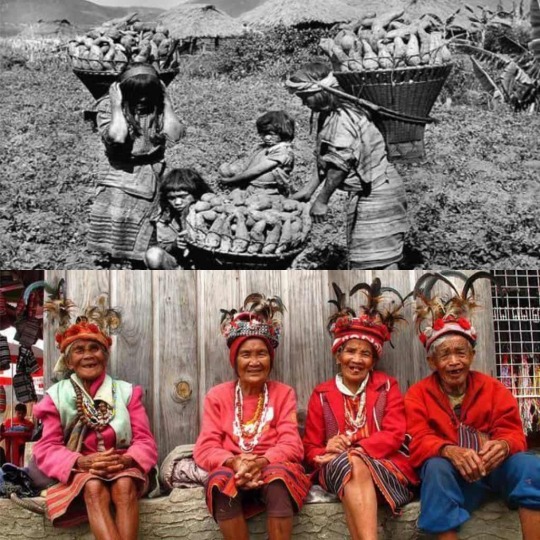
The Gaddangs
They're known by other names such as the Gadan, Gaddanes, Iraya, and Irraya, meaning “upriver”. They can be found in the eastern parts of Ifugao, the mountain province in Southeast Kalinga, and in the foothills of Cordillera Central. During the Spanish occupation, the lowland Gaddangs intermingled with other valley occupants, such as the Ibanags and Ilocanos, while others still, fled to the Cordillera and Sierra Madre Mountains to escape Spanish persecution. The population of this indigenous tribe is declining as they intermarry with and become absorbed by the larger groups. Their name derives from a combination of ga “heat” and dang “burned”, hence, they have have a darker complexion compared to other peoples of the Cordilleras. Chrisitans stereotyped them as 'untamed' and dangerous; in reality, they're of a calmer disposition compared to neighboring tribes.
The highlanders have maintained their unique culture, including their traditional costumes lavishly adorned with beads and precious stones. For instance, their ceremonial dress and ornamentation are some of the most elaborate and decorative; clothing of Western cut and commercial fabric are obtained from the lowland market. They have a penchant for decorating their clothes with beads, shells, buttons, and coins – sometimes covering significant portions of the clothing with ornamentations. Everyday attire, on the other hand, is simple, as evidenced by the men who don G-strings either in the homes or fields but don a pair of pants over their loin cloths when going to town. For ceremonies, men slip into loincloths (dinega), a small beaded jacket (koton), and cape (tapit).


The Itnegs
Itneg is an alternate name of Tinguian. Tinguian means "the people of the mountains," It was originally used to refer to all mountain dwelling people. These days it is particularly used to refer to a cultural minority group occupying the mountains of Abra. Music is an important aspect of Tinguian culture. Singing is a normal occurrence in the community and in the work fields. Their musical instruments are the "kalalent" (nose flute) the gangsa (copper gongs) and the "kulintang" (guitar). Economic life is based on agriculture. It is the principal source of income for the people. Agricultural products are rice, camote, yams, corn, squash, ginger, melon, sugar cane, fruits, and good quality cotton and tobacco. Aside from being farmers, they also do fresh water fishing, weaving various types of cloths and blanket, pottery making, and basketry.
A Tinguian village is usually headed by one of the old men or "lakay" chosen by a council of elder members of the village. A "lakay" is chosen based on his courage, health, wisdom and character. His role is to settle disputes in accordance with the customs and traditions. If a dispute is serious or the problem is new, he calls the council of elders or heads of influential families to discuss and decide with him.

The Kalingas
The Kalinga, also known as Limos or Limos-Liwan Kalinga, inhabit the drainage basin of the middle Chico River in Kalinga Province. The Kalinga are sub-divided into Southern and Northern groups; the latter is considered the most heavily-ornamented people of the northern Philippines.
The Kalinga practice both wet and dry rice farming. They also developed an institution of peace pacts called Bodong which has minimised traditional warfare and headhunting and serves as a mechanism for the initiation, maintenance, renewal and reinforcement of kinship and social ties.
They also speak the Kalinga, Ilocano, and Limos languages. Kalinga society is very kinship-oriented, and relatives are held responsible for avenging any injury done to a member. Disputes are usually settled by the regional leaders, who listen to all sides and then impose fines on the guilty party. These are not formal council meetings, but carry a good deal of authority.


The Ifugaos
The Ifugao call themselves as i-pugao or "inhabitants of the known earth"; other variations of the name are Ifugaw, Ipugao, and Yfugao. They live primarily in the province of Ifugao in Central Cordillera, in Northern Luzon. The name is supposed to have come from ipugo which means "from the hill." The Amganad Ifugao (Ifugaw) populate the central part of Ifugao Province and has two dialects: Burnay and Banaue. Additionally, their name is synonymous with the famous man-made Banaue Rice Terraces in northern Luzon, which had once been hailed the "eighth wonder of the world", and attributed to their engineering knowledge and agricultural terracing. Historically, Ifugao was one of the places in the Archipelago least influenced by the Spaniards, even though they did venture into Ifugao territory; the Spaniards were unable to transform their culture and values. Anthropologists have regarded the Ifugao as possibly the oldest residents of the highlands; their origin attributed to Indonesian migration, dating back as early as 800-500 BC.



0 notes
Text
Filipino Celebrations Through the Decades (Rivera, Montalbo, Ona, Luya, Nazareno, Maray, Buenconsejo, Barrion, Leonzon)
Our way of life is a major impression of our extraordinary and complex history. It is affected by the majority of the individuals we have communicated with. A mix of the Malayo-Polynesian and Hispanic culture with the impact from Chinese, Indians Arabs, and other Asian societies truly add to the traditions and conventions of the Filipinos. Filipino culture is one of a kind contrasted with other Asian nations, and convictions apply each average day for the Filipinos and uncover how rich and favoured the way of life the individuals have

ctto
Christening
In year 2012 the filipino tradition of baptism is they involves a priest baptizing a baby in private or simultaneously with other children. In a mass christening, the priest goes from one child to another, blessing them with holy water and performing the baptismal rite, as the parents and godparents respond in behalf of the children. The short church mass is held which serves as an orientation for the family, godparents, and parents. Baptism Ceremonies are important for Filipino Catholics because it is a step for welcoming the infants to being a Catholic. Sponsors (god parents) are charges Php 50. When the family of the baptized picks up the baptismal certificate a few days later they are charged an additional Php 50. Many families have a party or reception at home or fancy restaurants. It is always a big occasion for Pinoys. Also, they believe that they should get their babies baptized within three months of their birth.
In year 2017 they believe that the role of the godparents is to ensure religious educations for the children as well as caring for them in case they become orphaned. Godparents are expected to bring gifts or tokens for the godchildren during the christening celebrations. If you are chosen to be a godparent for a Filipino child, there are many gifts related to Filipino culture that you can give. They also have clothing rules for babies and for adult being baptized. For babies, both boys and girls often wear long white christening gowns when being baptized. The choice is made by the parents. For immersion baptisms, the baby wears normal clothes to the ceremony and white garments afterward to signify purity and the washing away of original sin. During a pouring baptism, the baby wears the same clothes throughout. While it is traditional for both males and females to wear white christening gowns, it is not required. A simple white nightgown or onesie is fine, and even colored outfits are now acceptable. Bring a towel to wrap the baby and a change of clothes for an immersion baptism. For adult, A collared shirt (for men) and a blouse that covers the shoulders (for women) are good choices. Some churches provide baptismal robes for adults who are being baptized, while other churches will want you to wear your own clothing. Check with your priest or church staff in advance. You should also find out if you will be baptized by immersion or pouring. If your church is providing a baptismal robe, you'll need to wear something comfortable underneath, such as shorts and a T-shirt. You could wear long pants, but you may be uncomfortable when wet. Bring a change of clothes for after the ceremony. If you will be wearing your own clothes, modesty is key -- don't wear anything tight, revealing or sexy. You'll be fine in what you normally wear to Mass on Sunday, but feel free to dress up. You may want to look your best for this special occasion.
In year 2019 they are so many requirements to do unlike the past few years. You have to go to church and inquire, attend the seminar, pass the Baptismal form and Birth Certificate a day after the seminar, and go to Church 30 minutes earlier than the official time. Also, in the year 2019 you really have to budget everything like for foods, decorations, christening clothes, cake, souvenir, baptism fee etc., And they really preparing for the baptism of the new member of their family.

ctto
Birthdays
2000
Ccelebrating birthday during year 2000 is simple yet fun. There are many visitors invited with relatives and the extended family just to attend the celebration, even those relatives comes from other cities and countries comes homes just to celebrate. There are mostly Gifts than money, there a lots and lots of toys than money because who hates toys? Everyone loves toys. Birthdays are way more fun before (in my opinion), there are less expenses just buy a cake, toys for the games and balloons would be enough. In every birthday this game will never be lost the piñata party but instead of a horse, it will be a pot containing candies and coins, it is the most awaited event of the time and the after party is the karaoke which every Filipinos like the most.
2010
During this time, there is so much no difference other than its venue and style. Events commonly held at any restaurant, hotel or clubhouse in their city, sometimes the celebrant decides to eat than to celebrate. During events in other places except their home, the activities never change, there is still piñata party, karaoke, games with a treat and more just like the activities way back 2000.
2019
In this time, birthday parties make a twist, like 7th birthday, 18th and 21st birthday. A lot of people make save a date video, pre video and during party videos, it is for the memories and souvenir for the birthday celebrant and it is more expensive, grander and more formal party. During this time, most of the parties or at least 20% of the birthday parties don’t have a lot of Filipino games anymore unlike the year 2000 and 2010. Birthday parties celebrated with gifts and events like candles, treasures, roses, photo booth with the guests look forward to, souvenirs and more. But it is exciting, Grand celebration and formal.

ctto
Holy Week
Semana Santa (Holy Week) is from Palm Sunday to Black Saturday, then Easter Sunday. It is traditionally a solemn occasion in the Philippines, a time for serious atonement.
Holy Week is when many people perform holy rites in fulfilment of a vow they made when they asked God a favor, such as a cure for an illness. Priests and religious statues are dressed in purple to symbolize gloom. Devout Catholics go to church everyday; some fast. Palm Sunday commemorates the entry of Jesus Christ into Jerusalem. Following the Spanish tradition, Filipino Catholics bring palaspas (palm fronds) to church to be blessed by the priests; then they bring the fronds back home with them.
For most of the week, especially after Tuesday, the towns are eerily quiet with TV and radio stations going off the air and no loud noises or revelry whatsoever. Catholics stop eating meat, turning to fish, and the more devout ones go on a completely liquid diet. Many businesses are closed, so make sure you have supplies, especially food, stocked up.The traditional pabasa (the “reading” or chanting of verses about the suffering of Christ) starts on Sunday and ends on Maundy Thursday, which is the day when the washing of the feet is celebrated.
Good Friday (Mahal na Araw) commemorates the crucifixion and death of Christ. On this day, you will see religious figures being carried through the towns on top of carrozas (carriages). The religious images and statues are veiled in black in mourning of the death of Jesus.There’s a superstition that warns against getting hurt on Good Friday… Any wounds you get on this day will never ever heal.
The most striking feature of Holy Week celebrations in the Philippines is the sight of Filipinos publicly whipping themselves. These are reenactments of the torture and death of Jesus. Some Filipinos not only whip their backs into a bloody mess — they also have their feet and hands nailed to a wooden cross. Tourists come from all over the world for the sight! In Manila, Tondo is the place to see these flagellants. Outside the capital, Pampanga and Nueva Ecija are famous for their flagellants who cover their faces with white cotton hoods. Crowns of thorns are placed on their heads to cause blood to drip.
Moriones Festival: Carrying the Cross Moriones Festival: Carrying the Cross
Among Filipino superstitions on Good Friday is the prohibition against children playing. This is because they might injure themselves and not have their wounds heal. You will always be reminded that during this time Jesus is dead, and so everything is awry and bad things are apt to happen.
Black Saturday is when Christ is entombed. Filipinos spend the day preparing for the night vigil leading up to Easter Sunday.
Easter Sunday is a celebration of the resurrection of Christ. At four o’clock in the morning, Filipinos do a salubong ceremony commemorating how the Virgin Mary met her son Jesus who has come back to life. Her image will be brought to the image of the Christ at the local church. Flower petals will be rained down on them. Everyone is happy that Jesus is alive again and that the world is back right. On Easter day, grocery stores re-open and you can buy food.
In contemporary times, these Philippine traditions are slowly disappearing. Young Filipinos now use the Holy Week to vacation at the beach.

ctto
All Saints Day
All Saints’ Day in the Philippines is usually celebrated on the first and second day of November. In the Philippines, this holiday is often referred to as Undas. The day is filled with music and food. There is also a prayer and religious tradition. At the end of the day, people will often camp overnight in the cemetery to pay their respects to their dead relatives. Visitors remark that Filipinos are remarkably at home among their dead ancestors. But now all saint day is just like a fashion day because of the teenagers are wear a different fashion clothes and something it look like a reunion, but the tradition in all saint day is still on they give flowers, candles, and most specially the prayer for their death
relatives.
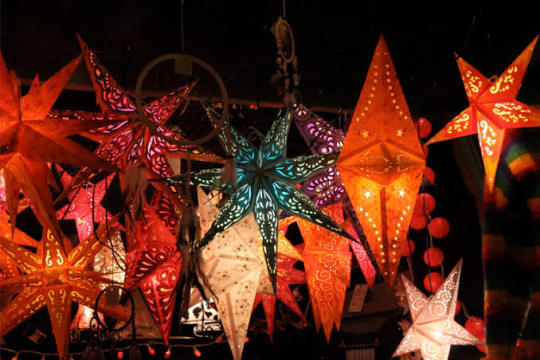
ctto
Christmas
Having most resident in the country are Christian (either Catholic, Born Again, etc.), Christmas is one of the most important holidays in the Philippines as Filipinos celebrate the day Jesus Christ was born. Also, most of the families have always gathered to give presents and enjoy the day with each other. Either they will go out and make some memories in different places or they will stay at home talking and catching up with their lives. Although, some people think that Christmas lately was not enjoyable as it was 19 years ago and lost the Christmas Spirit that we had decades ago.
Back in 2000s, most Filipino felt the presence of Christmas even though it was still September, as they thought that because it was the start of BER months, most of the families already bought Christmas Parol and designing their houses with Christmas lights and Christmas tree. You can also hear many kids that nangangaroling with different houses and expected to give even a little amount although most residence just tell them “patawad” instead. The weather was also cold that time. That was the time everyone felt that Christmas was near due to the coldness. However, now in 2019, it doesn’t feel like it. Although radio station started to broadcast Christmas songs in their station, it doesn’t have the impact as what it used to. Going around, most of the houses only started decorating when it was already December, some didn’t even bother. Also, kids who was nangangaroling was lessen that you might hear it only once a day unlike before when you are too annoyed peeking outside just to shout “patawad”. It’s not also as cold as 19 years ago. Due to climate change, even in BER months, the weather was still hot and it affected the views of the Filipino that if Christmas is near, then it’s also the time when the weather will be cold. These are the few that have changed between 2000 up to 2019.
However, some traditions were still practices until now without changes, the “Misa De Gallo” o “Simbang Gabi” and the Noche Buena. As most of Filipinos are Catholics, Simbang Gabi was still one of the traditions that was never been broken by the Catholics. They attend 9 mass whether it was at night or before the sunrise. It still goes on as some people believed that if a person completed the 9 mass, their wish will come true. Whether it is true or not, people still go to masses as one of the traditions in Christmas. Another is the Noche Buena. Christmas Eve was one of the most important in the country as most of Filipinos are having countdown to greet the Christmas day with everyone. It also the time when families, some relative, and friends having Noche Buena. This was the time where most of the families have several dishes like lechon, fruit salad, puto, hamonado, and many more. Some families have a tradition of exchanging gifts and having family games that everyone was involved. These two are the traditions that no one can break in a Filipinos mind-set during Christmas.
Every year, there are changes that keeps happening around us and of them is how we celebrate holidays. Although some instances affect the way we normally celebrated the Christmas, it was still one of the holidays that most of the families reunited with one another especially being with our family and having fun with them, whether staying inside in their house or going outside to make new memories with them. And that was the real spirit of the Christmas.

ctto
New Year
Filipinos' love for holidays and celebrations is superb - it is full of enjoyable, unique, and fun activities, alongside with some quirky traditions. In New Year's Eve, Filipinos cleans everything, scatters coins around the house to bring more luck and money, turning all the lights for the upcoming year to be bright, opening all doors, windows and such to draw in good fortune, wearing polka dots which signifies prosperity, making loud noises which is believe to scare away evil spirits, and jumping as high as you can to increase your height. But, of course no feast will be ever complete without a sumptuous meal and for the fact that food is what Filipino people love the most.
Media Noche is an old Filipino custom that is most likely inherited from the Spaniards. Whereas, family and friends gather together for midnight feast that signifies their hope for prosperity and an abundant year ahead. Food-related superstitions are also present such as preparing 12 round fruits and fruits with thorns avoided for it represents problems, noodles for a long life, eating sticky desserts for the family to stick together for the years to come, having the water and rice container full to make the whole year prosperous, and lastly not eating chicken am fish dishes because it is associated with food scarcity.
Lastly, customs does not end there -- in the New Year itself don't spend to lead to all a better financial management throughout the year and also not cleaning to keep the good fortune that came during the New Year's Eve. With this, Filipinos are truly fond of celebrations, traditions, and superstitions.

ctto
Fiesta
How did it get started?
During 1`500 the Spanish missionaries entered in he Philippines, they introduced Fiesta because they found out that it is the most convenient way to teach Filipinos the Roman Catholic Faith. Philippine Festivals are celebrations to express gratitude for a good harvest in honor of the town’s patron saint. For many Filipinos, fiestas are important because of the miraculous power of the saints.It is believed that the saints are responsible for all the good fortune and favor one receives. The majority of fiestas in the Philippines also have their own peryas. here are more than 42,000 known major and minor festivals in the Philippines, the majority of which are in the barangay (village) level. Due to the thousands of town, city, provincial, national, and village fiestas in the country, the Philippines has traditionally been known as the Capital of the World's Festivities.
NEW FIESTA IN THE PHILIPPINES
1. MAHAGUYOG Festival (Mais, Halaman, Gulay at Niyog)
March (1st week), Santo Tomas, Batangas
week-long celebration of seven-day feast in honor of St. Thomas Aquinas , 2012 when it is started
2. The Philippine International Hot Air Balloon
Fiesta is an annual four-day event held between January and February in Clark Freeport Zone, Angeles, Pampanga. It is the biggest and longest-running aviation sports event in the Philippines. Every 2nd week of February from 1994 to Present
3. AURORA DAY AND SUMAN FESTIVAL
February 14- February 19 | Baler, Aurora
Baler, Aurora
The biggest and grandest of all feasts in Aurora is a parade of floats uniquely designed. Main streets and homes are decked with suman, a native delicacy.
A weeklong celebration marked by trade exhibits, fairs and competitions capped by the Search for Ms. Aurora.
Suman(súmahn) is the filipino steamed rice cake. it comes in as many different forms as there are provinces, but the basic recipe is waxy (sweet) rice wrapped in leaves, then cooked.
Suman is the ritual gift of HAGISAN. It is cooked with great enthusiasm by Tayabenses because Hagisan is an opportunity to share their prosperity. Bundles of suman are gaily tied in the pabitin, which is made out of a special kind of bamboo called bagakay.
4. Mango Festival
Years Active 1999-present
The Dinamulag Festival also known as the Zambales Mango Festival is an annual festival held in the province of Zambales in the Philippines to celebrate or encourage bountiful harvest of the province's mangoes. The festival was first held in 1999.
5. Aliwan Fiesta
Aliwan Fiesta is an annual event that gathers different cultural festivals of the Philippines in Star City Complex in Pasay City wherein contingents compete in dance parade and float competitions. Aliwan Fiesta, which began in 2003, aims to showcase the different Filipino cultures and heritage not only to the people in Metro Manila but also to the rest of the world. The contingents, meanwhile, aim to promote their respective regions both economically and tourism-wise. It was originally organized as a visual extravaganza for the Christmas season, but it has since been held during the summer months of either April or May. Aliwan is a Tagalog word for "entertainment" or "amusement." Aliwan Fiesta festivities are covered live on DZRH News Television annually.
Here are the most famous fiestas in the Philippines:
1. Ati Atihun: Celebrating infant Jesus
The town of Kalibo, Aklan in the Panay Island rejoices in the exultations of this festival as people celebrate by performing tribal dance and music in the parade along the streets.
The festival begins with the opening mass for Santo Niño in the Church on the third Sunday of January, and the revelry lasts for the next week. The Ati-Atihan also bears a deep religious significance. The pahilot, a faith-healing tradition, is held during the festival where a Catholic priest rubs the devotee's body with the image of the Santo Niño, with the belief that it heals both the body and soul. No one is certain how Ati-Atihan started. One legend, however, says it dates back to the year 1212, when 10 datus, or patriarchal chiefs, and the companions fled from a tyrannical sultan in Sabah, Borneo, and landed on the island of Panay. Their leader, Datu Puti, traded with the chief of Panay, an Ati named Marikudo.
“Hala Bira ”
is an aklanon language meaning "pour/dispense all means". This term is also used during ati-atihan festival that most spectators are shouting on the street during the celebration. "Hala Bira" is an indispensable word during ati-atihan.
2. Sinulog Festival
Attracting millions of people every year, the Sinulog Festival in Cebu may just well be one of the biggest festivals in the country, and is surprisingly becoming even more popular each year, especially among the young people. It celebrates the image of the Santo Niño (Holy Child) that was originally brought by Ferdinand Magellan from Spain in the 16th century; hence, the words “Pit Señor” that you will constantly hear throughout the celebration, which is a plea to Holy Child.
Millions of people participated in Cebu City last Sunday to celebrate the Sinulog Festival, one of the most famous festivals in the Philippines. It was attended, not only by Filipinos, but people coming from different parts of the globe also went to witness the celebration. The magnificence of the festival made Filipinos, as well as our fellow Asians, refer to it as the “Mother of all Festivals”. From the colorful and well-made costumes of the dancers, to the beautiful dances and to the music brought by the drums, trumpets, and the native gongs, the Sinulog Festival never ceases to amaze its audience.
For 32 years, the Sinulog Festival is a traditional celebration in Cebu City held every third Sunday of January to honor the Santo Niño (Child Jesus). Basically, the festival is done by a dance ritual, in which it tells the story of the Filipino people’s pagan past and their acceptance of Christianity. The word “Sinulog” means “graceful dance”, wherein it all started in 1980 with a simple dance that represents the “sulog” (or current) of a river in Cebu.
3. Masskara Festival
Filipinos are known to be resilient people who are able find ways to smile and jest even amidst crises and adversity. This can be seen in the history of the Masskara Festival of Bacolod, which was an answer to the city’s dwindling revenue from the sugar industry. The festival is marked by dancers donning elaborate colorful masks parading all over town, backed up by Latin-inspired drumbeats. The celebration is highlighted by a beauty pageant, concerts, and sports events among its numerous activities.
4. Dinagyang Festival,
Another celebration in honor of Santo Niño, this award-winning fête in Iloilo is marked by a street party celebrated with bountiful food and drinks, concerts, and a street dance competition where different districts and local schools participate. It also celebrates the traditions of Aklan Island’s indigenous Aeta people.
5. Panagbenga Festival,
Also called the “Season of Blooming,” Panagbenga is a grand event in Baguio where giant floats adorned with flowers parade along the whole stretch of Session Road. A tribute to the city’s flower industry, it was first held after the 1990 Luzon earthquake to uplift the spirits of those who were affected by the tragedy.
6. Moriones Festival
The Moriones Festival is as unique as the island where it is annually celebrated. During the celebration, men and women who play the role of the “Moriones” are dressed in biblical Roman warrior costumes and intricately carved masks. They then reenact the seven-day search for St. Longinus, a Roman centurion who converted into Christianity. During the reenactment, they scare kids or conjure up surprises and tricks to draw attention. But the most exciting thing about the festival is that the audience gets to participate in the search for the person who plays St. Longinus who sometimes hides in townspeople’s homes.
7. Pahiyas Festival
Probably one of the most colorful celebrations around, Pahiyas Festival in Lucban, Quezon, is dedicated to San Isidro Labrador, the patron saint of farmers. Since it is a harvest festival, houses are gilded with colorful kiping (wafer made of rice) and fresh produce that you can pick for free. These décors are then judged by town officials and are given awards before the celebration culminates.
8. Parada ng Lechon (June 24 – Balayan, Batangas)
A grand parade of succulent roasted pigs. A different sight and flavor are introduced with a festival in Balayan, Batangas, popularly known as the "Parada Ng Lechon.” These succulent roasted pork form the highlight of the occasion, decked out in their platforms with all kinds of decor. Since the festival coincides with the feast of St. John the Baptist, be prepared to get wet as people observe the feast by repeating the ritual of baptism – pouring water.
9. Pintados Festival – Tacloban
If you're into tattoos and body arts then you might flip over the yearly celebration of Pintados festival in Tacloban when locals dance around the streets with inked bodies to symbolize the brave warriors of the past. Portraying the natives’ practice of idolatry along with their penchant for music and dance, this June 29th festival provides a glimpse of how the native people lived prior to the Spaniard's arrival.
10. Obando Fertility Rites – Obando, Bulacan
We'll wrap this list with a special kind of festival – the Obando Fertility Rites – held for 3 days from May 17 to 19. On these days in Obando, Bulacan, devotees do the fertility street dance to beseech the three saints, San Pascua, Nuestra Señora de Salambáo, and Santa Clara for good fortune, a spouse, or most especially, a child.
A lot of things change but also a lot of things will be the same. Filipinos will always be traditional and will always stick the things they do in terms of the celebrations here in the Philippines. That way they feel closer to their love ones each year.
0 notes
Text
Cordillera’s Religion: A Glimpse from the Past and a Leap in the Present
Bul-ul
We all know that the religious aspects of the Philippines are highly influenced by the colonization of the Spaniards. Fortunately, some of the oldest ethnic groups which has started long before the Spaniards brought Catholicism in the Philippines were least affected by it. Speaking of which, the Ifugaos are one of the few who successfully resisted these influences because of their fierce self-determination and geographic isolation. However, before we continue and go deeper into this discussion, let’s first go through their livelihood which has greatly contributed to the process of developing their animistic religion.
Rice cultivation is an industry common in most Filipino communities but rice paddies hand-contoured along steep mountain slopes which can be traced as far back as two millennia ago in the pre-colonial Philippines are one of the features unique in the country of Ifugao in the southeastern part of the Cordillera region. The Cordillera’s rice terraces are found in Ifugao, Mountain Province, Benguet, Kalinga, some parts of Abra, and Apayao. Over the years, the different provinces have come up with their own systems of preserving and managing their mountainous area of fertile which is their primary source of livelihood and food. Hence, we can say that agriculture played a big role and is entwined with the ways of life of the Cordillera people. This fact became their drive to create a tangible image that leads to the ascension/invention of the Bul ul.


Importance of Bul ul to the Ifugaos
Bul ul or anito figure is a mythical piece of Ifugao sculpture also known as a rice or granary deity. It is intrinsically important for the Ifugao’s cultural existence because it is solely believed to secure the palay harvest inside the granary or Ifugao house. It is also highly given respect and praise because it is said that the spirits of their dead ancestors live on it. Furthermore, it is regarded with utmost care and respect as the spirits may react with undesirable hostile manifestations such as sickness and pestilence if treated otherwise.

The process of creating this figure includes the baki or a ritual by the mumbaki or priest to assure that it is powerful and effective. It is carved out from a carefully selected narra wood or ipil wood by the elders in the forest and is ritually consecrated by coating it with pig’s blood. In some places during ritual rites, whenever bul uls are taken out from the granaries and being placed in front of the agriculture produce, a proper positioning of it is being observed—male bul ul must be on the right side while the female one must be on the left side facing the front of the agricultural crops.
Structure/Form
Bul ul takes the form of either a standing or seated human being figure and consists of a head, a torso that appears as a tapering triangular form and a pair of hands and legs mounted on a platform for stability. Moreover, the standing figure either features their hands either hanging beside the body or resting on their knees while the arms of the seated figure is typically folded.
It is usually made in pairs, male and female, but not necessarily—depending upon the request of the owner of the rice field. It could be a male or a female but normally, a male bul ul is preferred because Ifugao strongly believed that it should be the one that is highly respected for it can do the duty of guarding the rice granary alone. Do you ever wonder of its size? The truth is, there is no rule or a standard measurement that exactly defines its size, however, the capability of one man to carry it in and out of the granary is a consideration.
Ornamentations may be placed on the bul ul occasionally. For the male bul ul, a g-string may suffice while a tapis or waistcloth with earrings and anklets to match may be used for the female. But normally, the bul ul remains in an austere image—bold exposing both the genitalia.
Sadly, Bul uls are now taken out of their original context and have lost their ritual significance. Thus, it has been reduced to a variety of souvenir items and decorative arts placed in Filipino houses.
Christianity and the Ifugaos

The Ifugaos are commonly known to be a believer of animism, a religious belief where objects, animals, or plants are considered to be sacred and holy. However, since Christianity’s influences are strong and mobilized, the Ifugaos are also subject to this.
The road for Christianity into the Cordillera region is once impossible due to the impenetrable land formation of the place. The Cordilleras is landlocked due to the Ilocos Region and Cagayan Valley surrounding the region. However, evangelization was not withdrawn.
The Nature of Ifugaos
Even though after the difficult process of getting through the region, another problem arose when the process of evangelization was being pushed through.
Ifugaos are known to be very defensive towards their culture and traditions. They were met by fierce resistance from the people. They (Ifugaos) refused that their lands and their cultural identity be taken away from them by foreign invaders and colonizers (Quitasol, 2018)

Resulting Outcome

Still, after all the commotion, the Cordilleras was introduced to Christianity. It was a long road for it but it was finally accepted and learned by the members of the region.
Now, 65.75% of the Cordillera Region are Roman Catholics, according to the Philippine Statistics Authority. Many Ifugaos now have been practicing Christianity but still having their traditions and culture as an Ifugao.
Religion has been a very sensitive topic to touch. Yet, it is an interesting one. Change is inevitable. The transition of parts of the CAR to Christianity was noteworthy to our history. It might be overlooked by many but being ignorant to such topics is never a good idea.
So, let us respect and learn more about others for a better society.
Tolentino, Sabater 2020
0 notes
Text
Culture, traditions, beliefs, and way of living (Habacon & Del Valle F.)
Cordillera Administrative Region (CAR)
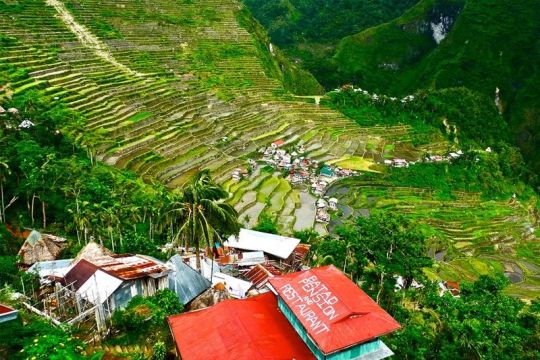
cctto
This region doesn’t just hold the agriculture and mining industries of the Philippines but within those majestic mountains lays fortress from the earliest time of our ancestors. Imagine a place that preserves the tradition and culture of Cordillerans, specifically the Igorot. The Igorot (Mountain people) were the tribes that exist till now and still exhibits the traditional practices, such as clothing, wedding, and many more.
Weddings
As a Filipino, I’ve witnessed a lot of weddings. I mean the typical weddings that happened today. But in the province of Cordillera specifically Baguio, the typical Bayanihan still occurs during traditional weddings, wherein the people in the community are all invited. Neighbors and other people will eventually volunteer themselves to help in the occasion. Which we all know is a common trait of the Filipinos. Moreover when we attend typical weddings, you will encounter bands, singers, and dance numbers to entertain you, for short they hire them for entertainment, luckily in the CAR region, the elderly and youth will help entertain by using strike musical instruments to the guest of a wedding because it is there a way of “makikiisa” to the couple. This traditional entertainment is accompanied by traditional of love and courtship to mark the occasion.

cctto
On the other hand, typical weddings usually occur only for a couple of hours but in the traditional wedding it runs for the whole day and it can last till the next day as well, that’s how they enjoy and treasure the special occasion that is happening. Before the wedding starts old men at night would chant to call the spirit of the anito (traditional deity) to bless the gathering. As the music and dancing continue, the bride and the groom danced along with everyone. And of course, the visitors are not exempted from joining in the fun. During the wedding, the wedded couple would wear their traditional clothes during the ceremony and the reception part.
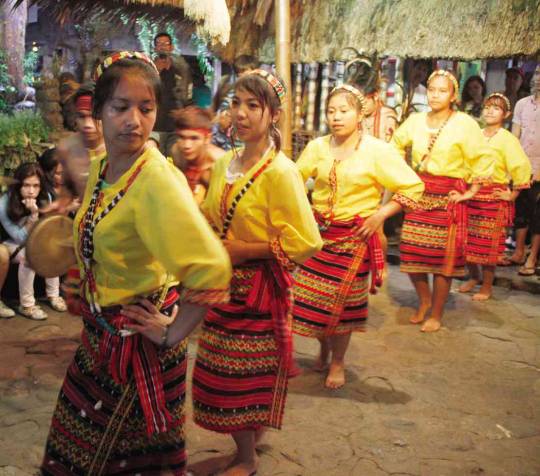
cctto
Tattoos

cctto
In Bontoc, Kalinga and Ifugao, the tattooing practice was common in the 16th century for the major warrior groups. In the past, men are usually tattoo practitioners while female practitioners were rare. The Batok’s (the general term for tattoos) designs were usually abstract and geometric that followed a similar pattern and form. It covers a man’s chest, back and other parts of the body. These were considered a painful rite of passage, body decorations, something that would give a bit of good luck, a sign of bravery and a symbol of status. These tattoos are also seen as a place of memories, experiences, and information. It signifies a collective ethnic identity.
The Farewell
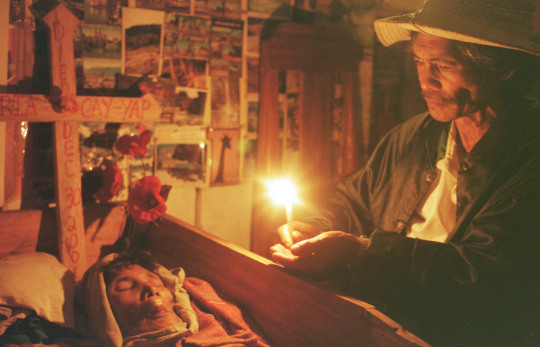
cctto
The burial rituals for the Ifugaos started in pouring rice wine on the ground as an offer to the spirits. The dead are clothed with torn blankets or dead attire to protect its a spirit in the afterlife. A sacrificial pig’s skull will be hung by the family of the dead outside their home to guard. For the wake, mourning and celebration in honor of the dead are allowed and the burial is postponed for at least three days after death. The family makes the dead seat on a chair outside their house so that they would be seen by the people or the mourners. There would be women who vigil, crying and shaking the body to make sure that the dead is truly dead since the Ifugaos believe that the soul and all signs of life might return to the body within the day. After three days, they believe that the soul already departed for good. Next is the celebration, Canao or the burial celebration lasts for days and involves ceremonial feasting throughout the village. For the second burial, they bury the dead near their home. They leave them for one to two years. Once it decomposes they will clean the bones and keep it on special mausoleum or at home.
Siesta (Every Filipino Living)
Each one of us has a different way of relieving our stress and rewarding ourselves after a long day of work or should I say our very own TGIFs (Thank God It’s Friday). But for me as a student, the way I want to relieve my stress is to grab my favorite cup of coffee after class and just appreciate my hard work for that specific moment

cctto
Meanwhile, the Filipinos before simply spend their siesta time drinking kapeng barako together with their co-workers after work and talk about the struggle, their love lives and mostly they brag about their little achievements to their Kumapares (Male Close friend) that they purchase something expensive or their wives went to the other country to work. A small kind of chitchat that will simply ease their minds and reward themselves after a tiring day of work. Besides coffee, they love to drink tuba and Lambanog (Local Alcoholic drink) while bonding with their co-workers and friends as well, another way to say that they finally reached the week of resting and to just be in the moment that they want to be.
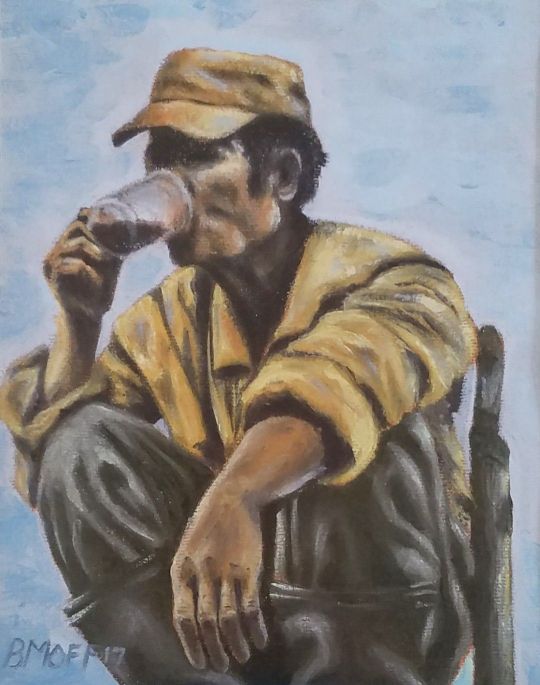
cctto
Now, the siesta time of the Filipinos is still the same but somehow modernized a lot. From drinking outside the house of your Kumpare to partying inside a hall of people drinking beer and rewarding themselves, but the fact that some people still drink outside their house is more comfortable rather than going inside a place full of lights and noise. While when it comes to coffee, before you have to boil a hot pot of water and mix the kapeng barako that you love, now you can just grab your favorite coffee in your favorite coffee shop and spend time for yourself. For me, it’s much better spending time with myself so that I can contemplate about life and how I should let myself grow for the betterment.
0 notes
Text
Philippine Clothing: Then and Now (Group 3-4/4(Balbacal and Pascual)
How well do we know about fashion and clothing in the Philippines? Aren’t we curious about how Baro’t Saya and Barong Tagalog became our National Costume? Yes, it’s been discussed when we were kids, but apart from the display we see in the Filipiniana section of department stores, the costume worn at school and the formal wear donned during public state affairs, how do young Pinoys know about our traditional dress?
The Philippines has been greatly immersed in foreign influences particularly by Spain, Japan, and America. Lifestyle, culture, and fashion sense have been mainly defined by influences from the countries as well. Filipinos are innate, creative, and experimental; these influences gave them ideas on how to mix and match the clothes.

ctto
Long before the coming of the Spaniards, the natives of the islands were already wearing clothes. Men wore a collarless, short-sleeved coat called “kangan” and a strip of cloth called “bahag” wrapped around the waist and between the legs. They also wore “putong” a piece of cloth worn around the head. The women wore a wide-sleeved blouse called “baro”, their skirt walled “patadyong”. They also wore “salakot” (native hat) as protection from heat and sudden rain.

ctto
Spain colonized the Phiippines for 300 years and Filipinos picked up their conservative way of clothing. Modifications were made in the Filipino fashion sense. What is now known as the Barong Tagalog is the result of the evolution of the “kangan”. Laces, trimmings and adornments, and collars were added to the simple collarless shirt. Embroidery and buttons also became apparent on the kangan while the bahag was then replaced with trousers. This is also the same for the female costume counterpart of the Barong Tagalog, the Baro’t saya.
Barong Tagalog (a formal garment often made from the fabric and richly embroidered) is used both by men and women. It looks like a tunic or shirt with long sleeves and is worn over a usual shirt. Filipino men often wear barong tagalog with a Chinese collarless shirt called “camisa de Chino”. Barong Tagalog can turn European-style clothing into Filipino easily. It is ornamented or embroidered with traditional patterns and it can be made from various fabrics, mostly natural like piña fabric (hand-woven from pineapple leaf fibers), jusi fabric (machine-woven from banana silk), and banana fabric (hand-woven from banana fiber).

ctto
Barong Tagalog is as well used by women, but there are many much more feminine and beautiful female clothing. An example is the mestiza dress. It is a formal dress made from lace and embroidered richly. It has butterfly sleeves that add charm on the dress. Actually, mestiza dress is a version of Baro at Saya but more sophisticated. Baro at Saya means blouse and skirt and has a lot of variations. It is very typical for people in the Philippines to wear Baro at Saya. In the past, it used to be just a short blouse with long sleeves and a long wrap-around skirt. But today, this national costume can be very ornate and beautiful.

ctto
The Spaniards introduced the natives on how to wear shoes and hats. A sash was also worn high across the waist with loosely fitted trousers paired with slippers or shoes. During the American regime, “Americana” was introduced, the westernized suits and jackets. Women wore “terno” dresses with butterfly styled short sleeves and “panuelo”, a Filipino national dress. The different ways to how men and women dressed during the American regime is a symbol of the power struggle between the Americans and Filipinos.
Although we’ve claimed our independence from the Spaniards, we cannot deny the fact that their influence in fashion industry is still being much used until the modern era. American colonization influenced the Filipinos to a modernized form of clothing. They introduced light materials like cotton since Philippines is a tropical country. However, due to the culture of the Spaniards being conservative that Filipinos have adapted, it took some time to accept the idea. Nonetheless, as of today's date, it is clearly evident that we have embraced it. Women now wear comfortable clothes on a daily basis instead of the layering Baro’t Saya. Men now wear simple cotton shirts instead of Barong Tagalog.
Today, we can now see how fashion style has drastically changed. We can easily compare it to what and how our native clothes back then. Imagining the looks on the older generations on what the teens are wearing now is unbelievable. We can see how conservative they were back then and now, we can wear clothes exposing our skin. Legs were hidden from long dresses and the 21st century brought many changes to the Philippines fashion. Cropped tops, ripped jeans, white tees, types of denim are now commonly used on a daily basis.

ctto

ctto
Although these changes have been totally adapted, “Barong Tagalog” and the “Filipiniana terno” are still constantly being used as a symbolization for Filipino tradition and culture.
There is still no distinct Filipino style since we are colonized but somehow, we have learned how to make our own styles. Bahag is still being used in the Northern region of the Philippines so native clothing will not be out of the Philippine culture.
Moreover, Philippines is still adapting different styles from other countries. And Filipinos being creative, we always look for which is more convenient yet very classy and promising--that’s why Filipino designers are being acknowledged all over the world.
1 note
·
View note
Text
Exploring the Wild Side of Cordillera Culinary Culture (ALBAO/VALEROS)
The Cordillera mountain range supplies 80% of the Philippines' daily vegetable requirements, but the folks prefer to eat meat -- smoked, boiled, grilled -- using the simplest cooking techniques with long preparation techniques. Pinikpikan is a dish that is rooted in the native ritual of reading signals from the gods to determine one's course of action. Sometimes called 'Battered Chicken,' native chickens, smaller in variety with darker, tastier meat are beaten with a wooden and grilled over open fire. If you’re looking for their local food that is similar to the usual Filipino dinuguan, Pinuneg might be the one for you. It is a native blood sausage composed of minced pork and innards mixed with cooked rice (usually the red variety) salt, vinegar, garlic and other flavors and then stuffed into clean animal intestines. The Cordillera version of the longganisa (native sausage) is then either sun dried, smoked, poacked or simply boiled and served as a main course or appetizer with a vinegar and chili dip. There is also the Tapuey, sometimes called Tapuy or Tapey, a native wine made by fermenting rice with a special yeast in a clay or wooden jar using mountain spring water, resulting in a strong brew popular at cañaos or mountain feasts. A great souvenir to bring home or give as a gift, it is available in bottles at the Baguio Market. If you’re a coffee lover, there’s also in it for you. The famous Benguet Coffee. It was introduced by the Spaniards and later became the favorite beverage of the Cordilleras. In fact, it is the first thing a native will offer you when you visit his home, and what he expects you to offer him when he visits yours. Mountain Rice Organic mountain rice, reddish in color, referred to by locals as kintoman, is commonly served in Baguio restaurants and in homes. It is considered a healthy, flavorful alternative to white rice. The Cordillera culinary culture is pretty controversial. There are restaurants openly selling dogmeat, horse meat and goat meat in Baguio City. In fact, that is the culinary culture in the Philippine highlands -- to convert everything edible into food and to use all parts of the animal or plant possible. Their food is a testament to the ingenuous, frugal, resilient and organic nature of the wonderful Cordillera people.
0 notes
Text
The Filipino Food Through the Years (Group 3-3/4(Luciano and Mendres)
We, as Filipinos, love to eat, right? For every occasion, we’ll always have something on our tables. Even though we don’t have much money for it, we’ll always find way. But did you know that most of the food that we eat these days somewhat came from other places and cultures? Most of the original cuisine we prepare these days evolved or have a certain way of cooking, but they still have its main ingredients. Wanna know when and how this kind of food happened to get into our tables? Well, here are the places and timeline where this food came from.
THE PRE-COLONIAL FILIPINO FOOD
Characteristics of a pre-colonial food shows us what taste of originality is like. Pre-colonial food here in the Philippines actually originated from the Malay cultural matrix, but despite that, the Philippines still developed culinary preferences of its own which are a clear indication of a unique Filipino lifeworld.
So what are these characteristics of a pre-colonial Filipino food?
Ingredients used during this period are vegetables, fish, meat, spices, and condiments from the landscape. The methods of cooking are boiling, roasting on coal, and simmering in vinegar.
POPULAR FOOD DURING THE PRE-COLONIAL PERIOD

SINIGANG
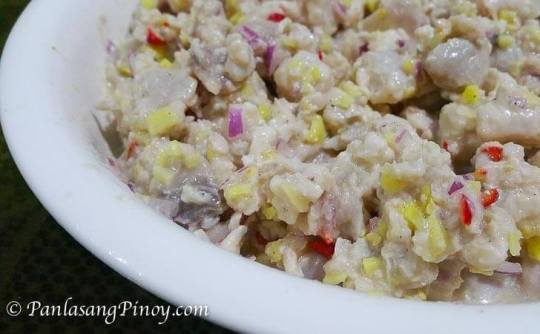
KINILAW
FOREIGN INFLUENCES ON THE FILIPINO FOODSCAPE
Colonization in the Philippines happened and the arrival of foreign influences introduced some developments in Filipino cuisine. Foreign ways of cooking and foreign ingredients have been adapted by the Filipinos, indicative of the evolution of the Filipino lifeworld as reflected in its evolving foodscape. But despite the foreign influences, the essence of Filipino cuisine was preserved. Foreign food influences were indigenized to fit the Filipino palate.
INFLUENCES AND ITS CONTRIBUTIONS TO FILIPINO CULINARY CULTURE
Chinese
Chinese Soybeans, curds, certain pork and beef cuts, pansit mami, bihon, sotanghon, siopao, siomai, crullers, and cooking with oil in a wok.
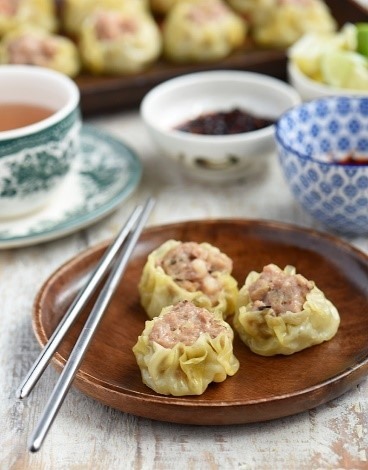
ctto SIOMAI

ctto SIOPAO
Spanish
Stuffed capons, beef rolls, the stews of meats, the sausages and vegetables (cocido, pochero), leche flan, brazo de mercedes, sans rival.

ctto LECHE FLAN

ctto POCHERO
American
Frozen and pressure-cooked foods, foods portable and quick

ctto FROZEN HAM
THE FILIPINO FOOD TODAY
The Filipino food at present consists of both pre-colonial Filipino food and the Filipino food with a fusion of Chinese, Spanish, American, and other influences. The food we traditionally prepare has developed in a good way because we, Filipinos, are experimental with the food that we prepare. We have this thought that being traditional is boring so most of our food has a twists in it. For example, the frozen ham that the Americans introduced to us is sometimes being cooked with egg and the Leche Flan that the Spanish’s introduce is now being sold in graham cakes. This is why it’s more fun here in the Philippines--you’ll never get bored with our cuisines.
0 notes
Text
All About Music: A Leap Into the Past and Investigating Music Fad (Delvalle,Libang,Lisboa,Mesina,Perada,Reyes G, Reyes M)

ctto
Music plays an integral part in our everyday living. Because the music industry continues to rise, it is nearly impossible to go an entire day without hearing some snippet of music along the way. Music, in this case, has completely different views and meanings to distinct individuals. As far as studies had found, music is unambiguously an individual’s attribute. It also influences our mental performance and skill to get things done. These qualities and effects of music are just some of which that justifies the study of music, specifically, music taste or preference or the popular genre of music then and now. Looking into all of these, we may go beyond our imaginative expectations, this will expand our horizons and perhaps outcomes may give us an idea of music as guide to therapy and personality development theories, and a human performance proponent. Who knows exactly what’s the limitation of music in relation to humans? Despite being so complex, music— certainly tells a lot about us.
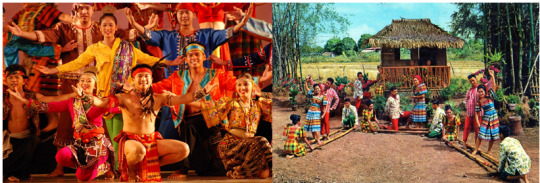
ctto
Way back before the years of colonization, music was already a part of Filipinos’ daily life and even during special events. We Filipinos have that so called "Mga Awiting Bayan" which includes Oyayi (used as lullaby), Kumintang (which is sang during wars), Diona (song during weddings) and many more. Music plays an important role to everyone because it could be a way to express their thoughts and feelings but for some, the music represents the richness and diversity of culture and tradition of a particular place.

ctto
It was during the American colonization, specifically during the year 1898 to 1946, here in the Philippines, that the Americans introduced blue folk music and rock and roll. In the year 1950's, rock and roll songs with Tagalog lyrics had been adapted resulting as the origin of Philippine Rock.
Until the year of 1970's, rock music had been the most popular genre of music here in the Philippines, but during the late 1970's, Filipino songwriters tried to combine Tagalog and English lyrics to produce new songs which leads to a birth of a new genre in the music industry of the Philippines which is the Pop Music or Philippine Pop in which afterwards became the inspiration of music artist and composers to have our own music style which is known as the Original Pilipino Music, now more commonly termed Original Pinoy Music or Original Philippine Music or OPM for short, which originally referred to Philippine pop songs.
In the year 1980's, subgenres of OPM suddenly emerges like the Folk rock which includes music with rock and counterculture style and also the OPM Christmas songs. In the year of 1990's subgenre of Philippine Rock was introduced after developing Philippine rock with hard rock, heavy metal, and alternative rock. In the Visayas they introduced their own subgenre which they called the Bisrock, a subgenre of Pinoy rock, propagated by the Cebu rock music industry in the Philippines. The term, which is in the blended form, comes from the Cebuano words Bisaya, referring the Visayan languages, and "rock", for rock music. Meanwhile in Pampanga, they also produce their own subgenre which is the Rockapampangan that became an idea whose time has finally come, after folk, classical, acoustic and pop music, they think about mixing kapampangan lyrics with Rock music.

ctto
In the year 2000, the music industry has brought different genres which enriches the OPM. One of this is the Jazz which is a type of music of black American origin characterized by improvisation, syncopation, and usually a regular or forceful rhythm, emerging at the beginning of the 20th century. The Philippines has always been a home for Jazz in Asia. Introduced by American soldiers, the genre opened up many opportunities for Filipino performers who have turned it into a musical tradition in the Philippines. Other accounts say that its roots can be traced back to the early Filipino settlers of New Orleans. Jazz as an expressive and improvisational music has found affinity to the traits of being a Filipino. the Philippines became largely open to all things American, including Hollywood movies, food, and Jazz music. Some popular Filipino Jazz artists are Louie Reyes, dubbed the Philippine Queen of Jazz, Bong Peñera, Fred Elizalde, Tito Mina, among many more. One more genre is the Rap which is an hip hop music performed by musicians of Filipino descent, both in the Philippines and overseas, especially by Filipino-Americans. The Philippines is known to have had the first hip hop music scene in Asia since the early 1980s, largely due to the country's historical connections with the United States where hip hop originated. Rap music released in the Philippines has appeared in different languages or dialects such as Tagalog, Bicolano, Chavacano, Cebuano, Ilocano and English. In the Philippines, Francis Magalona and Andrew E. are among the most influential rappers in the country, being the first to release mainstream rap albums. Apl.de.ap of The Black Eyed Peas, Cassie Ventura, and Chad Hugo of the Neptunes and N.E.R.D. are among the contemporary Filipino-American hip-hop artists. And of course, the Reggae, Filipino reggae or Pinoy reggae is reggae music created in the Philippines. The country has several bands and sound systems that play reggae and dancehall music in a style faithful to its expression in Jamaica. Reggae in the Philippines comprises the many forms of reggae and its subgenres, and at times combining traditional Filipino forms of music and instruments in their music. Cocojam is known as one of the first Filipino reggae bands. Ska also found its place in the Philippines, with many bands forming, especially in the Visayas region. Cities like Dumaguete and Cebu became the hub of Filipino ska.
Usually, taste in music is different for each generation but according to George Gershwin, “true music must repeat the thought and inspiration of the people and the time” and there are indeed some genres of music that are not bound by generations and is liked by both the old and young. Examples of these genres are rock which was introduced by the Americans during the late 1950s and jazz which was introduced to us Filipinos when African-American soldiers landed in the Philippines to fight the war against the Spaniards however, according to a documentary based on Richie Quirinoâ award winning book Pinoy Jazz Traditions, Filipinos who jumped the Spanish galleon ships were the first Filipinos to come face to face with jazz when they found their way to New Orleans where jazz music was just taking shape as ragtime, blues, brass and other musical traditions collided and eventually fused to take different new forms.
Where do our preference in music come from? Since music exist in every culture, some scientist wondered whether our musical tastes are inborn. Although some of our preference are from biology and some are from the people around us and the culture that we lived in.
According to Josh McDermott, people strongly prefer genre and notes that are correlated with the music they are exposed to. We prefer the one that we are familiar with and the music we are mostly exposed to are the ones that we mostly hear from stores, movies, and radio. According to Dr. Shahram Heshmat, due to the repeated exposure, it increases our liking as a process of conditioning our mind into liking the music with the same tune, genre, and musical artist as a form of classical conditioning. However, extreme exposure may lead to habituation.
Our musical reference also reflects on our personality and identity because it is who we are. We prefer genres that matches our personality and these genres reveals important information about our nature. According to Kendra Cherry, a study shows that indie fans are mostly introvert, intellectual and creative; and country music for those who are hardworking, conventional and outgoing. Meanwhile in identity, we often choose the music styles that are related to us and communicate it with others. By sharing your musical preference to others, you are telling them that you believe in some traditions and values like others with the same preference in music.
Another one common factor that influence our preference in music is our age. According to Heshmat, from late adolescent throughout adulthood, we began to form our preference in music. Music from childhood to adolescents are the ones that creates long lasting memories. From the teenage years, it creates strong nostalgic feeling until adulthood. Throughout the years, music preference change as we age. According to the study of Arielle Bonneville-Roussy, adolescence prefer intense music such as punk and metal to contemporary music such as pop and rap until the beginning of middle age years to establish an identity. For early adulthood, mellow music such as R & B and electronic is introduced which is considered as romantic and positive. And for the last musical age, sophisticated music such as jazz and classics, and unpretentious music such as country, folk and blues are more preferred. This is due to the changes in social and psychological development.

ctto
Did you know that our music taste tells us not only about our personality, age, but also our social class? Social class is a division of society based on social class and economic class. According to the study from Canadian Review of Sociology, our music preferences informs us our cultural attitudes and our way of listening. Lower class people prefer country, oldies and heavy metal. However, higher class people preferred choral, classics, rock, and musical theatre. The study shows that higher class people dislike heavy metal and country, meanwhile, lower class people dislike classics and choral. The likes and dislikes of higher class and lower class creates boundaries between the two.
Culture, society, brain and identity plays a vital role in choosing genres, tunes and artist as one of our musical reference. As it affects our taste in music, it also affects us sociologically and psychologically as it influences our personality and social life. Our musical preferences reflect our personality, identity, age, mood and life, on what kind of life, we lived in and what are we truly feeling. By knowing more and understanding our musical preferences better, it may help us know and discover more about ourselves and others, with the use of their taste in music. This also helps us in understanding another person’s mental health state by knowing their music preference and listening behavior. Therefore, music affects us in different ways, however, all this results to status, life and self.

ctto
Comparing then and now, both the type and purpose of music in our culture has changed drastically. Some of our traditional pre-colonial music has almost vanished, if not completely forgotten altogether, and as time goes on and as globalization introduces more different kinds of music from other culture, the higher the chances of our traditional pre-colonial music. That does not mean however that Pinoy music will be lost in history as, though it may have changed and had been influenced due to us being colonized, Pinoy music is still on the rise globally. In fact, according to Gautam Talwar, Spotify’s new managing director for south-east Asia, OPM content has surpassed 10 billion streams in 2019. This goes to show that as our culture opens up to the world and be influenced by other cultures’ music, we, in turn, are able to share our ever evolving Original Pinoy Music with the world.
3 notes
·
View notes
Text
Filipino Language: Slangs and Lingos Through the Years (Group 3-2/4 (Caguicla and Pabiloña)
As Ernst Haeckel said “Nothing is constant but change”, our language has been on the continuous phase of evolvement. It may not be noticeable but as we speak, few of the uttered words are influenced by other languages which is mostly due to being colonized by several countries from the past or simply because of too much exposure on Anime or K-dramas. Some are slangs adapted from the everchanging fads and trends.
The Makata Way

ctto
During the American regime, Filipinos were not permitted to speak Tagalog, our native language, and were forced to speak English, a language stranger to their native tongue. As the Japanese came, our forefathers were granted freedom on employing our own language. This event provided an opportunity for them to showcase their love for our language, therefore giving birth to the “Makata”.
The Makata consists of people using formal speech as they converse while socializing. Having the possibility of our grandparents belonging to said group, they were given the title “The True Image of Makata” Our grandparents would babble about their childhood and traditional courtship around their time repetitively whilst reminiscing those times. They are also witness of the golden age of Tagalog language – with the love poems that some might’ve still kept, the kundimans, and even the simplest conversations we heard from them daily.
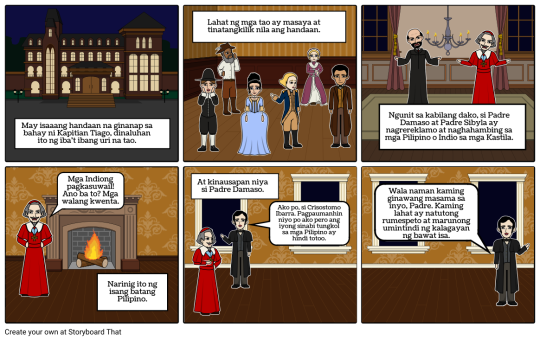
ctto
Jose: Marikit na binibini, maaari ba kitang dalawin sa inyong tahanan mamayang dapit-hapon?
Maria: Kung iyong mamarapatin, ika’y hindi ko muna mapapahintulutang gumawi sa aming tahanan.
Jose: Kung iyan ang iyong ikaliligaya.
Maria: Sana ako’y iyong mapagpaumanhinan.
In modern times, conversations similar to the given sample are considered “utterly rustic.” Even if being makata shows a Filipino’s manifestation of love for our own country, the population of the group dwindles as time evolves.
SLANGS
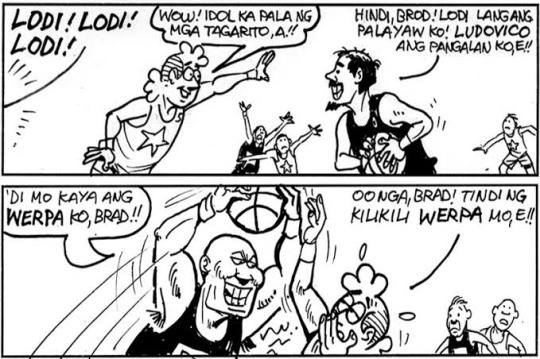
ctto
As the “Makata” is gradually vanishing, a modification of our language emerged. Being our resourceful and creative selves, new words or slangs arise from our native tongue. Slangs are informal words or expressions that are not accepted in formal or standard language (mostly used for educational and/or work-related purposes). Linguists have no simple and clear definition regarding slang, but agrees that it is a constantly changing linguistic phenomenon present in every subculture worldwide. Usually heard from teenagers, several Pinoy slangs were born in the country around the 80’s and became popular. It is still being widely used nowadays, and even the word Pinoy is a slang itself.
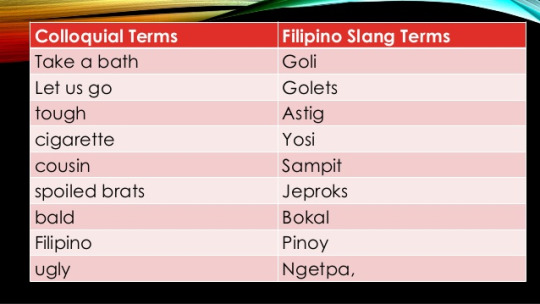
ctto
1. Ermats/Erpats – Mother and Father 2. Tsekot – kotse
3. Senglot – lasing 4. Anda – pera
5. Epal – taong mapapel 6. Yorme – Mayor
7. Matsala – Salamat 8. Ngangers - boring
The words enumerated above might sound off and could have caught the attention of the “Grammar Police,” but these words, whether we like it or not, are already part of our culture.
JEJEMON

ctto
The era of “Jejemons” began around the early 2010’s. Throughout that time, they became the talk of the town and were seen in some newspapers, magazines, radios and even televisions here in the Philippines. With people either having conflicting feelings and opinions about them, they just laughed it off or joined the fad. “Jeje” is a short term for “Jejemon” pertaining to people who excessively use uncommon letters (“x” and “z”), punctuation marks, and even numbers in every word or sentence they construct. It is mostly used by teenagers at the time via text messages. According to Jejemon users, “Jeje” might have originated from “Hehe,” an onomatopoeia that denotes laughter in terms of writing. They only replaced the Letter “h” with letter “j”. While, “Mon” means monster similar with the suffix of the Japanese animation Pokemon. Some Jejemons exert their effort to make the most out of the 360-character limit for every text message. While the latter remove bowels to shorten words leading to more complicated spellings and messages.

ctto
GAY LINGO

ctto
With their rapid population in the Philippines, the gays have managed to create a language with the purpose of avoiding people who eavesdrop or possibly for comical purposes. What they have come up with is the Swardspeak or Gay lingo, a colorful language created by mixing English, Tagalog, Visaya, Spanish and as well as celebrity names and trademark brands, giving them new meanings in different contexts. This language is not just any other, it goes with some certain rules.
The “JU” Law
It is a process of replacing the first syllable of a word with “Ju” or “Jo”

ctto
Juding – punta, to go Jombag – umbag, to punch
Jutay- maliit, small Jowa – asawa, boyfriend/girlfriend
The Name Game
Used when words are formed by replacing a word with a name of a famous person that sounds identical to the word.
Bitter Ocampo – Bitter, sad
Chiminey Cricket – Chimay, maid
Debbie Gibson – give
The gay lingo also makes use of adding an extra syllable, letters or words to create a new and different word.
Crayola – cry Cookie Monster – to cook Bigalou – big
It also twists the meaning of a word/s, as if putting it in a different context.
Backstreet Boys – cute boys at the back
X-Men – mga dating lalaki
Thunder Cats – gurang
Due to the popularity gained by the aforementioned language, other genders also joined the ride. This lingo has also undergone its own evolution and into a brighter and fresher one, the BEKINESE which is simply like a conversation icebreaker. People who excessively used Bekinese are referred to as the BEKIMONS.
Since 1500’s until now, our language, Filipino is undergoing several changes and transformations. New words that seem unfamiliar to the native tongue are continuously being used and accepted. In a few months, a new language might be derived from our language with new words and expressions. Yes, those languages might be created for fun; however, tables might turn. Maybe one day, we’ll wake up with a new language greeting us a good morning whilst our very own native language will be lost in our dreams.
0 notes
Text
Tattoos: Before and Forever (Group 3-1/4 (Kaur and Flores))
Art is what we use to express and apply our skills, creativity, and imagination—be it in literature, dance, music, or painting.
When painting, we can improvise our own canvas, and one of them is our own body as it has been used in the past. Before the colonialism of the Spaniards in the country, tattoos were considered as body art and pride as it symbolizes the accomplishments and rank of the individual, while some even believe it has magical qualities. Although the first recording of tattooing was documented in the late 16th century, it is believed that people have been practicing this art since the prehistoric era. It was widespread, but due to Christianity, the practice was considered heathen or low-class.

ctto
The tattoo designs and tools used in the past has many similarities with the Polynesian. Whang-od, from the Butbut people of Kalinga, is said to be the "last" and the oldest “mambabatok”. Mambabatok is a person who uses the traditional method of tapping the ink into the skin by using thorn or needle and wood. Her apprentices are composed of women as she broke the patrimonial tradition. She uses the traditional way of tattooing as well as indigenous materials.

ctto
However, from manual to mechanical, tattoos have emerged into the age of technology. As tattoos developed, the goal of the people behind getting their skin inked has changed. The tattoo from the Kalinga promoted collectivist culture for the indigenous used to get tattoos based on a community, whereas the modern tattoos bolster individuality since the design is based on own unique preferences. As the old ways of inking the skin are said to be dying, Filipinos are making attempts to revive the ancient art of permanently designing your body. Katribu Tatu is a tattoo and piercing shop located in Pasig City. It incorporates the traditional tattoo and modern tattoo by inking cultural designs on the skin using modern tattoo equipment.

ctto
Moreover, Tatak ng Apat na Alon or Mark of Four Waves is a Los Angeles-based Filipino tribe that aims to continue batok or the tapping method. One of the members from the said tribe visited Whang-Od with his own design etched into his skin, and to his surprise, she was pleased to see his own craft.

ctto
The art of tattooing has walked on a rough road, but it still stands today. Motives might have change depending on the person, but tattooing is still rampant in the Philippines. On a negative note, tattoos are associated with behavior. People with tattoos are seen as thugs or criminals. Nevertheless, tattoos have been providing comfort and confidence to those who have their skin imprinted. It is to remind them of something they cherish and will cherish through a lifetime, for a tattoo is a forever companion.
0 notes
Text
Group 5 (Petrache, Galuyo, Viaña, Torrejos, Acierto, Exconde, Bajade) part 2/2
Brgy. Malitlit, Sta. Rosa, Laguna

Centro De San Lorenzo Subdivision, Barangay Malitlit was very clean, spacious, and there were just a few people who lives there way back 1995. It is divided into four subdivisions: Phase 1-A, Phase 1-B, Phase 1-D and Phase 1-E. Back then, this subdivision only has one terminal for tricycle, and it is in Phase 1, that is why some residence in other subdivisions necessarily walk so far just to get from the commercial places like Enchanted Kingdom, Balibago, etc. We do not have much food restaurants inside the community as well as hospitals, so they needed to go to Bayan’s. The only hospital that is so close to the subdivision is the St. James Hospital located near Dita.
In Phase 1, the Casa Del Niño Montessori Santa Rosa is the only school inside our subdivision so many children’s and teenagers goes to Saint Michael’s College of Laguna in Biñan. Also, they do not have much food restaurants inside the community as well as hospitals, so they needed to go to Bayan’s to buy some essentials. The only hospital that is so close to the subdivision is the St. James Hospital located near Dita.
However, after five years, our community gradually improved up until now and it became better than before. There have been schools, primarily number one private schools throughout the subdivision – the Emmanunel Christian School. There is also a food stalls within each subdivision especially in Phase 1 and Phase 1-C. In the past, every feast, the clubhouse in Phase 1-C has a perya, but they had to remove it due to the complains of some people because there were a lot of fights that is happening before.
Most food stalls, dining and small cafes are built on Phase 1c and Phase 1, due to their large subdivision and are often visited by people because all the delicious foods and dining places were there, there are also mini groceries and much more. I'll mention the popular sites here in San Lorenzo Subdivision. First are the food stalls in the clubhouse, which is one of the best places to eat snacks, such as fishball, squidball, kikiam, kwekwek, turban, bananaque and other street foods like isaw, barbeque, etc.


Second are the fish markets – people usually go here early in the morning because they want to buy some fresh fish, porks, beef and the pig’s blood for dinuguan. Especially in Phase 1C because there are many fish markets in line. Third stand out places in our subdivision is what we called here carenderya or lutong ulam – it is very famous here because of its delicious recipe especially when it is 12 o’clock noon. Many people were buying and eating here and some of them were tricycle drives in the terminals, they really have a delicious dish.

The fourth famous spot here in San Lorenzo is the Phase 1C - Clubhouse. There is always a bunch of people there because of the basketball court, while some of them are playing volleyball. Sometimes, people rent the clubhouse for events like pageants, concerts, talent portions and graduations that is why there were so many people especially when there are events.

Fifth one is the clingy café in Phase 1C, they sell some nachos, fries, smoothies that is so very delicious. They also have a free card games that is why many people go there to hang up with their friends.Their foods are somehow pricey, but it is worth it. Also, there were milk tea shops nearby and the famous diner in 1C, the Pares ni Julas – bunch of people ate there every night because of its delicious beef pares.

Sixth is the Mini stop – this is the first big convenience store built inside the San Lorenzo Subdivision. People sometimes go here to hang up and eat with someone especially when it is in the middle of the night because the people inside our community love road trips and you can see it in Phase 1. And then, the unlimited buffalo wings, a lot of people go there because of its saucy chicken and spicy unli wings – it is located in Phase 1 main road near mini stop.

Lastly, the computer shops. Group of people always go there to play games such as DOTA, Rules of Survival, LOL, etc. Especially the boys, they even spend their whole day just to play games and some of the computer shops here in Centro De San Lorenzo do have a ps4 – “play station 4.”
Brgy. Concepcion, San Pablo, Laguna
Immaculada Concepcion Parish
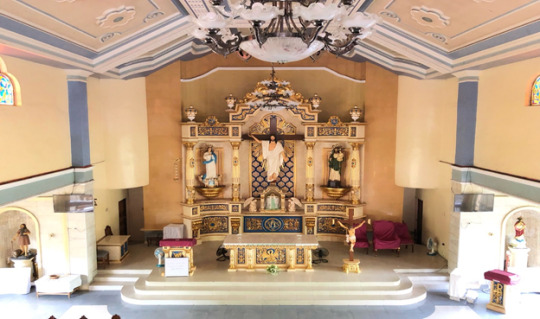
It symbolizes the faith of the people living in Barangay Concepcion. It has a very peaceful ambiance to it. The church also has different organizations, like Youth for Christ which encourages the youth to join activities that’ll help them establish a deeper relationship with God.
St. Peter’s College Seminary
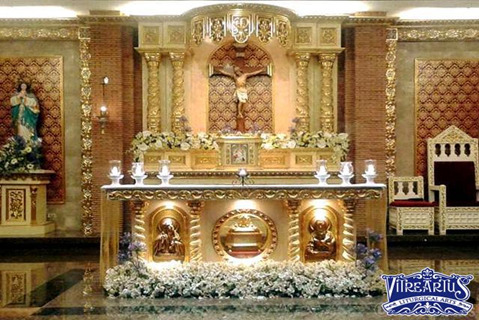
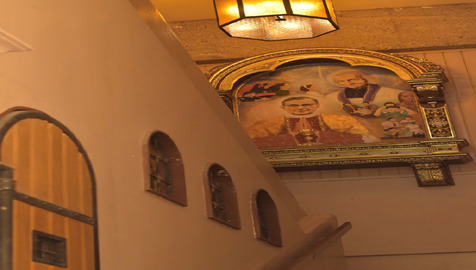
It used to be a killing field before it became a college seminary. Also, the reason why the land where the seminary is situated was donated was because of its bad luck. The seminary was named St. Peter’s College Seminary in order to emphasize the bond of faithful obedience that the diocese has always rendered to St. Peter the Apostle and to his successors. Back then the seminary only has one building for the college seminarians when there is no Senior High School yet, however, now they build another building for the Senior high that’s why they’re expanding. They used to accept senior high school students under the HUMSS strand but they will no longer be accepting senior high school applicants this year because of so many conflicts in the system.
Cusina de Sabang 602

It is a restaurant that serves “putok batok” cuisines such as lechon and patatim, what makes this restaurant a hit is that its location has an overlooking view of Bunot lake. The place was also windy that actually makes it the best place for wedding receptions, family gatherings, reunions and many more.
ABS-CBN Film Production chose this place for Kathryn Bernardo and Daniel Padilla’s movie, Barcelona: A Love Untold. It is said that many productions are asking for their consideration to film their movie in the place, however they declined it because they don’t want the place to be destroyed
Ella Isabelle’s Restaurant

It is a Filipino family style restaurant that serves a “lutong bahay” dishes so that eventhough you are not in your own houses you can still feel the vibe of a home when you eat
The inside of the restaurant is wonderful but the outside at night is marvellous. The lights are everywhere that will make you feel comfortable in any way.

This is just outside and near the St.Peters College of Seminary, that’s why most of the families go here after the mass because its’s near and more convenient.
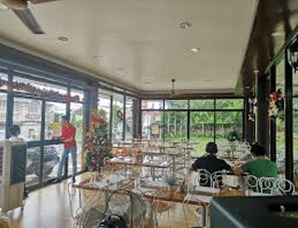
Rizal, Laguna
When we hear the word Rizal, the first thing that comes into our mind is our national hero, Dr. Jose Rizal. What most people don’t know is that there is a small town in the province of Laguna, which is named after him. A small town with very few people, and lots of coconut trees.
The town of Rizal is known for various practices, but its most popular and oldest tradition is celebrating Christmas on January 6 and not December 25. Most Rizaleños do not wake up at 12 midnight of December 25 to eat their noche buena because they are used to celebrating Christmas at 12 midnight of January 6. During this time of the year, Rizaleños are accustomed to celebrating in the streets and drinking with their peers, and one drink that is famous among Rizaleños is lambanog.
Lambanog is a traditional Filipino drink made from coconut sap. Aside from being accessible, it is also very affordable that’s why it is loved by Filipinos especially by the masses. But recently, just before Christmas, several people from Rizal died because of methanol poisoning due to drinking lambanog. Because of this incident, the town went under the state of emergency and was banned from drinking lambanog.

Another tradition of Rizaleños is to hike the town’s most famous attraction, the Tayak Hill, during Lenten Season. Every Holy Week, locals and even tourists gather up the hill and stations of the cross are placed specifically for those who are willing to do it. In addition, families hike the hill during that time of the year as an annual rite or as the locals like to call it, “penitensya”. It takes about an hour and a half to get to the summit. At the top is a large white cross, a Noah’s ark, and a viewing deck where you get to see a very picturesque view that is perfect for selfies, groufies, and even photoshoots. The trail up to the hill is safe and child friendly for it has barriers that will prevent someone from falling.
Rizal may be a small town, but it is full of people who are very warm and welcoming. Their old traditions are what make the town and the people unique and different from others. So do not miss the chance to visit our small yet amazing town, Rizal.
0 notes
Text
Group 5 (Petrache, Galuyo, Viaña, Torrejos, Acierto, Exconde, Bajade) part 1/2
The Philippines is undeniably a country of rich culture and tradition. The country’s culture before and after the colonization gave birth to diverse and meaningful practices and traditions which varies in every part of the country. These traditions have been passed down to generations and has been kept alive because of the great effort of the people who embraces them and values its importance. Through this blog, readers will be given a clear view of the uniqueness of the country’s culture by seeing it in the eyes of the people who lives in their own special place in the Philippines. Here are a few places in the country which might interest you;
Oas, Bicol
Every December, my family travels 12 to 15 hours to Bicol to celebrate either Christmas or New Year there; we either stay in Guinobatan with our cousins or in Oas near the beach to unwind. Oas is a mixture of beach resorts, fishermen, and farmers. Boats who sailed far out in the ocean would always dock in front of resorts to sell their catch of the day, but sometimes boats do not go far to catch fish. The water in Oas is so clean there are fishes near the shore, like dilis and this lionfish the children are trying to kill because it was deemed poisonous.

In catching dilis, a boat would cast a net offshore, some fishermen will disturb schools of fish in jumping into the net by slapping the water, then several men will pull the net off the water and into the beach. Some passerby will pull as “pakikipag-kapwa” but pulling the net also means having a share in the catch.
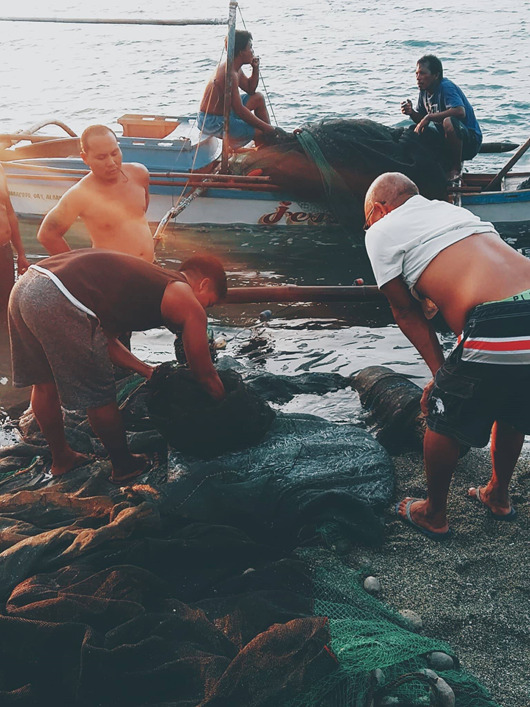
After the net has been successfully hauled out of the water, those who helped pull the net will then get their share of the catch by bringing in their own pail.

Liliw, Laguna
Liliw, a town that is popularly known as the Footwear Capital of Laguna. People from far places tend to visit Liliw because of its quality products when it comes to footwear but that's not the only reason why Liliw is popular.
Every year, Liliw is celebrating the Gat Tayaw Tsinelas Festival that lasts for a week every April 22 - 27. The highlights of the festival are the floats that showcases the agricultural and industrial products of the town, mainly using their famous footwears as the design of the floats.
Along the Gat Tayaw Street, shoe stores are decorated with products colorful shoes, slippers, sandals and even bags of different designs and materials. Some of the winning entries in this years “Pinaka Maganda na Malaking Tsinelas” contest
At the time of the festival the footwear stores at Liliw were beautifully decorated with colorful slippers, sandals, shoes and other products that they make like bags. There's also a competition called "Pinaka Maganda na Malaking Tsinelas" wherein footwear store owners together with their employees will make a massive slipper and display it at the front of their store as their entry for the competion and a panel of judges roaming the town will decide who wins the contest.

There is also an annual street party, Mutya ng Liliw, Chorale competition, and the “Tsinelas on the Ramp”, a fashion show featuring great quality footwear that is proudly made in Liliw Laguna.
According to the Municipal Mayor Ericson Sulibit, Liliw is known as a cold water spring resorts destination back in the days and tsinelas made from coconut bark is just one of their local products. Over the years, local backyard footwear makers started to use various local and imported materials until it became Liliw’s signature product.
Aside from the week-long festival there's also other traditions in Liliw which is the Lukayuan, a part of old culture in upland barangays of Oples and Ibabang Sungi where some barrio folks wear costume to turn performers appearances a mere disguise. Bailete is a unique ritual traditionally done on feast of barangays wherein town folks perform the dance on the street while drinking wine specifically lambanog.
Victoria, Laguna
Laguna has a lot of towns and Victoria is one of those; the said town may not be known nationally but there are actually a lot of things that our town is proud of. The people in Victoria has a lot of traditions that still upholds until now. Just like any other town, we celebrate our fiesta in the most astonishing way.
Itik is the main product of the town of Victoria in Laguna. This small, bustling town is the center of the duck industry in the province. Itik or Duck Festival of Victoria Laguna is being celebrated annually in line with its town’s founding anniversary every November.

The festival is being held to commemorate how itik gave honor to the municipality. One of the highlights of the event is the Itik Festival street dancing joined by students from public and private schools. The schools literally treat this street dancing as a friendly competition; all of them pours their best to be the winner who will bring home the prize.
At 5 a. m., the young and the elderly clad in multi-colored attires the likes of the Itik-Itik, flooded the major thoroughfares in this municipality for a parade cum prayers and dances that took off from the town plaza, encircling poblacion barangays where well-wishers gladly welcome and lauded them for their untiring effort in exhibiting the people’s traditional culture amidst modern practices influenced by technological advances, Victoria has not escaped to be an exception.
Another one is the food tasting, during the festival a lot of people will show every delicacy out of itik. Most of the time this activity will always be held on the opening of the celebration and it was also featured a lot of times in morning TV shows.
There is also one event in that seven day celebration that a lot of Victoreños are always looking forward for; the Governor’s Night which there will be a lot of performances and entertainment from local artists and stand-up comedians.
Also, during that night the residents have a chance to win valuable and exciting prizes in raffle draws that are always sponsored by the government body. It includes grocery packages and some appliances that are very useful in everyday living.
Since the introduction of the Itik festival in 2002, thousands of foreign and local tourists, visitors and students from other Laguna towns and nearby provinces in Calabarzon toured Victoria to witness how Itik are being raised and to see for themselves the delicacies out of Itik.
1 note
·
View note